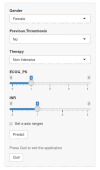Venous thromboembolism in patients with acute myeloid leukemia: development of a predictive model
- PMID: 38632595
- PMCID: PMC11022429
- DOI: 10.1186/s12959-024-00607-6
Venous thromboembolism in patients with acute myeloid leukemia: development of a predictive model
Abstract
Background: Patients with acute myeloid leukemia (AML) are at increased risk of venous thromboembolic events (VTE). However, thromboprophylaxis is largely underused.
Objectives: This study aimed to determine possible VTE development risk factors and to develop a novel predictive model.
Methods: We conducted a retrospective cohort study of adult patients with newly diagnosed AML. We used univariate and multivariable logistic regression to estimate binary outcomes and identify potential predictors. Based on our final model, a dynamic nomogram was constructed with the goal of facilitating VTE probability calculation.
Results: Out of 626 eligible patients with AML, 72 (11.5%) developed VTE during 6 months of follow-up. Six parameters were independent predictors: male sex (odds ratio [OR] 1.82, 95% confidence interval [CI]: 1.077-2.065), prior history of thrombotic events (OR 2.27, 95% CI: 1.4-4.96), international normalized ratio (OR 0.21, 95% CI: 0.05-0.95), Eastern Cooperative Oncology Group performance status (OR 0.71, 95% CI: 0.53-0.94), and intensive therapy (OR 2.05, 95% CI: 1.07-3.91). The C statistics for the model was 0.68. The model was adequately calibrated and internally validated. The decision-curve analysis suggested the use of thromboprophylaxis in patients with VTE risks between 8 and 20%.
Conclusion: We developed a novel and convenient tool that may assist clinicians in identifying patients whose VTE risk is high enough to warrant thromboprophylaxis.
Keywords: Acute myeloid leukemia; Nomogram; Predictor; Thrombosis; Venous thromboembolism.
© 2024. The Author(s).
Conflict of interest statement
The authors declare no competing interests.
Figures




Similar articles
-
Derivation, validation and assessment of a novel nomogram-based risk assessment model for venous thromboembolism in hospitalized patients with lung cancer: A retrospective case control study.Front Oncol. 2022 Oct 10;12:988287. doi: 10.3389/fonc.2022.988287. eCollection 2022. Front Oncol. 2022. PMID: 36300098 Free PMC article.
-
Venous Thrombosis Risk after Cast Immobilization of the Lower Extremity: Derivation and Validation of a Clinical Prediction Score, L-TRiP(cast), in Three Population-Based Case-Control Studies.PLoS Med. 2015 Nov 10;12(11):e1001899; discussion e1001899. doi: 10.1371/journal.pmed.1001899. eCollection 2015 Nov. PLoS Med. 2015. PMID: 26554832 Free PMC article.
-
Implications of cytogenetics for venous thromboembolism in acute myeloid leukaemia.Thromb Haemost. 2015 Jan;113(1):201-8. doi: 10.1160/TH13-12-1020. Epub 2014 Oct 23. Thromb Haemost. 2015. PMID: 25339605
-
Prophylaxis of thromboembolism during therapy with asparaginase in adults with acute lymphoblastic leukaemia.Cochrane Database Syst Rev. 2020 Oct 10;10(10):CD013399. doi: 10.1002/14651858.CD013399.pub2. Cochrane Database Syst Rev. 2020. PMID: 33038027 Free PMC article.
-
Venous thromboembolism risk with contemporary lenalidomide-based regimens despite thromboprophylaxis in multiple myeloma: A systematic review and meta-analysis.Cancer. 2020 Apr 15;126(8):1640-1650. doi: 10.1002/cncr.32682. Epub 2020 Jan 8. Cancer. 2020. PMID: 31913498 Free PMC article.
Cited by
-
The Comparison of Classical Statistical and Machine Learning Methods in Prediction of Thrombosis in Patients with Acute Myeloid Leukemia.Bioengineering (Basel). 2025 Jan 13;12(1):63. doi: 10.3390/bioengineering12010063. Bioengineering (Basel). 2025. PMID: 39851337 Free PMC article.
-
Venous thromboembolic risk in hematological hospitalized patients: a retrospective study.Ann Hematol. 2025 May;104(5):2963-2971. doi: 10.1007/s00277-025-06397-9. Epub 2025 May 6. Ann Hematol. 2025. PMID: 40325237 Free PMC article.
-
Insights into Cancer-Associated Thrombosis Leading Towards Ischemic Stroke.Biology (Basel). 2025 Jan 10;14(1):50. doi: 10.3390/biology14010050. Biology (Basel). 2025. PMID: 39857281 Free PMC article. Review.
References
LinkOut - more resources
Full Text Sources

